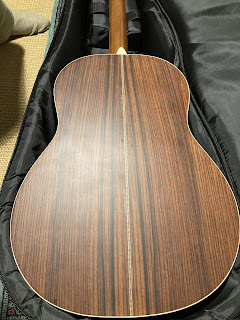I recently got hold of this guitar. I thought for the record I'd try to gather together some of the things I found out about it. In the interests of accuracy, I've not been able to verify much of the history of this guitar because there is so little information out there and some of the information is contradictory. I'm very open to any corrections because of this, and will amend the review in the light of any new evidence.
Framus
The early history of this company is well attested and I won't add too much here as the internet has lots of information about the company formed in Germany after the Second World War to make instruments. The popularity of the guitar post war, made this instrument the prominent production of the company rather than classical instruments. There's loads more information here https://www.framus-vintage.de/en/About-Framus/History/ The original company went into administration in the late 1970s. What's interesting in the story of the FDG 20 S is that Hans-Peter Wilfer, son of the founder of Framus, revived the marque in 1995 as part of the Warwick company. I have an early 2000s Warwick bass which is superbly crafted and one of my favourite instruments. Certainly to begin with the Warwick influence rubbed off on Framus and led to some very, very good Framus instruments being produced.
Warwick/Framus have no online information about the acoustic guitars they produced in the mid 1990s. However, as I have trawled through the sparse internet references to this guitar, it would appear that the FDG 20 S is one of the first guitars the company released following the relaunch of the Framus brand. While Framus is most known for more midrange and quirky instruments in the 1950-70 period, in the 1990s they went relatively high end. If the conflicting reports on the internet are to be believed then the FDG 20 S production was probably outsourced to Japan, and overseen by a master luthier named Hansu Piita Uiruha. I can find precisely nothing about this luthier on the web, and nothing to confirm that these guitars were in fact made in Japan. The guitar itself has no indication of the country of manufacture. It would appear that they were only made for a very short run between 1995-7 and are therefore fairly rare.
The Guitar
This is a bit of an easier task to describe as I have the guitar in front of me so I can verify most of the details of construction!
The guitar is a matt finished, slope shouldered dreadnought. One internet seller claims that the top is AAA grade spruce. It is certainly solid spruce with very good and pleasing, close, straight grain. Over 25 years or so this has aged to a rich brown colour, much darker than my early 1980s Takamine which has travelled across the globe with me. The back and sides are of solid rosewood, very nicely grained, finished and bookended, with a marquetry divider between the back pieces, which looks extremely classy. The neck is mahogany with a bound rosewood fingerboard and bridge. The bridge and nut are of bone and well finished. The frets on mine are slightly worn but still very playable. The action is superbly low, with no bottoming out of the strings. It’s wonderful to have a guitar this old that is so playable. My 1980s Takamine is the same and a testimony to Japanese craftsmanship. The Framus is beautifully inlaid with abalone blinding and rosette. The headstock is black with well executed mother of pearl inlays. The inlays on the fretboard are pearloid snowflakes. Here is the first small gripe as they are set into filler in a drilled circular hole rather than routed to shape, which is a bit disappointing, although only noticeable on close inspection. The second gripe is that inside the guitar there is some glue overspill showing on the joints, which mars an otherwise very well executed guitar. The machine heads are gold grovers and of extremely good quality. Generally despite the couple of gripes the guitar is very well finished indeed, and not showing many signs of wear or any signs of structural issues after 25+ years of service.
Because the action on this guitar is very low it is extremely easy to play, with no choking of the strings anywhere on the neck. The tone is superb, less bassy than my Eastman, but very good for fingerstyle as the note separation is impressive. It is loud like a dreadnought should be, but strong on dynamics, sounding lovely both played gently, and with more vigour. I'm grateful that, unusually for a guitar of this vintage, no-one has tried to butcher it with any pickups, so there are no unsightly holes or dated preamps on the highly resonant body. Playing unamplified with other musicians the instrument holds its own very well.
The good news is that these guitars can be bought quite cheaply if you can find one. You would have to spend well in excess of £1000/£1500 these days to get anything close in quality, more if you wanted that quality made in Japan. But of course Framus is not so well known, and Warwick sadly have cheapened the Framus brand acoustic guitars with some very uninspiringly average current production models. I hate it when companies do this but we are in harsh times. This gem of a guitar is old and a relatively unknown quantity, so you may find one for a very reasonable price indeed, as I did. If you find a good one, as I was fortunate enough to do, you won't be disappointed with the richness of the sound, the quality of the finish and materials.





No comments:
Post a Comment